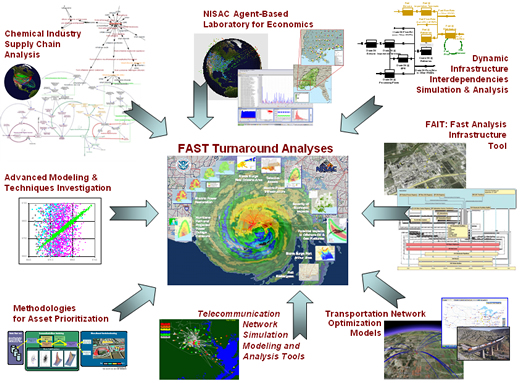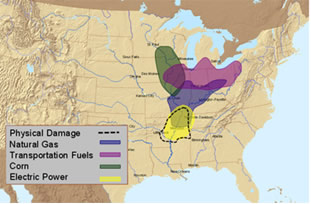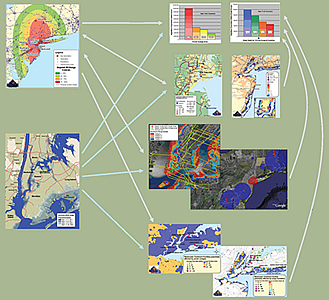About the National Infrastructure Simulation and Analysis Center
Short address
- - Short address: http://wrhch.org/bbs/?t=Z Copy address
body text
About the National Infrastructure Simulation and Analysis Center
- Infrastructure Analysis and Policy Planning
- Incident Response Fast Analysis & Simulation Team
- For Further Information

The National Infrastructure Simulation and Analysis Center (NISAC) conducts modeling, simulation, and analysis of the nation's critical infrastructure. NISAC analysts assess critical infrastructure risk, vulnerability, interdependencies, and event consequences.
NISAC began as a collaboration between Los Alamos and Sandia National Laboratories in 1999 and was incorporated by the USA Patriot Act of 2001 into the Department of Homeland Security upon its inception in March 2003. The Office of Infrastructure Protection oversees NISAC operations.
Requests for information or analyses are prioritized and supported by the Homeland Infrastructure Threat and Risk Analysis Center (HITRAC). Joint NISAC/HITRAC ventures often are undertaken to create or advance a needed capability to support multiple governmental decisionmakers.
NISAC plays a vital role under the National Infrastructure Protection Plan (NIPP), which relies on robust public-private information sharing to protect and build resiliency for the nation's vast infrastructure. The center's multidisciplinary expertise covers the full spectrum of 18 critical infrastructure sectors while focusing on the challenges posed by interdependencies and the consequences of disruption. (See section 6.3.2 of the NIPP.)
NISAC researchers and analysts conduct extensive modeling, simulation, and analysis to support risk mitigation and policy planning. They also provide real-time assistance to Department decisionmakers during such critical incidents as hurricanes, flooding, wildfires, and manmade events.
Infrastructure Analysis and Policy Planning

NISAC analyses help planners prepare for and respond to events that threaten or affect critical infrastructure. Because catastrophic events such as hurricanes and earthquakes do not follow jurisdictional boundaries, NISAC focuses on cross-discipline, cross-jurisdictional preparation and response.
In-depth analyses provide a better understanding of infrastructure disruption impacts and the effectiveness of mitigation strategies. For example, NISAC analyses of possible hurricane consequences greatly aided the Gulf Coast region in preparation and response planning for three hurricanes in 2008.
Analysts also integrate expertise from the center's core partners, their collaborators, and system experts. HITRAC staff serve as customer liaisons to clarify requirements and increase communications between NISAC and study sponsors.
NISAC's planning analyses include:
- Pandemic influenza
- Chemical supply chain
- High-voltage transformers
- New Madrid seismic zone
- Hurricane scenario analyses for Atlantic and Gulf Coasts
- Food defense
- Global finance and payment systems
- California water systems
- Power grid
- Southern California earthquakes
- Infrastructure asset prioritization
Incident Response Fast Analysis & Simulation Team

A central resource point for the Department, NISAC's Fast Analysis and Simulation Team (FAST) provides practical information within severe time constraints in response to issues of immediate national importance within severe time constraints. FAST uses NISAC's long-term planning and analysis results, subject matter expertise, and suite of models to rapidly respond to questions on affected sectors, the consequences of infrastructure interdependencies, and potential economic impacts.
HITRAC staff help integrate NISAC analyses into other Department decision processes to increase situational awareness and assure the best possible products within time constraints. Other government agencies also make use of NISAC's analytic skills and technology.
Examples of NISAC's FAST analyses:
- U.S./Mexico and U.S./Canada cross-border transportation corridors
- Midwest flooding impact
- Cross-border pipelines
- NYC bridges and tunnels
- International asset
- New England water infrastructure
- Hurricanes Katrina, Rita, Wilma, Gustav, and Ike: Pre- and post-landfall impacts
- Minnesota oil pipeline explosion
- Minnesota I-35W bridge collapse
- Southeast drought
- Southern California wildfires
- Mexico critical energy infrastructure
- Key chemical facilities and chokepoints
For Further Information
To help in planning and readiness, NISAC pre-incident studies and other reports are made available to security partners through the Homeland Security Information Network.
Learn more about NISAC from NISAC-HITRAC@dhs.gov and from Sandia and Los Alamos National Laboratories.





Comments list
No comments have been registered.